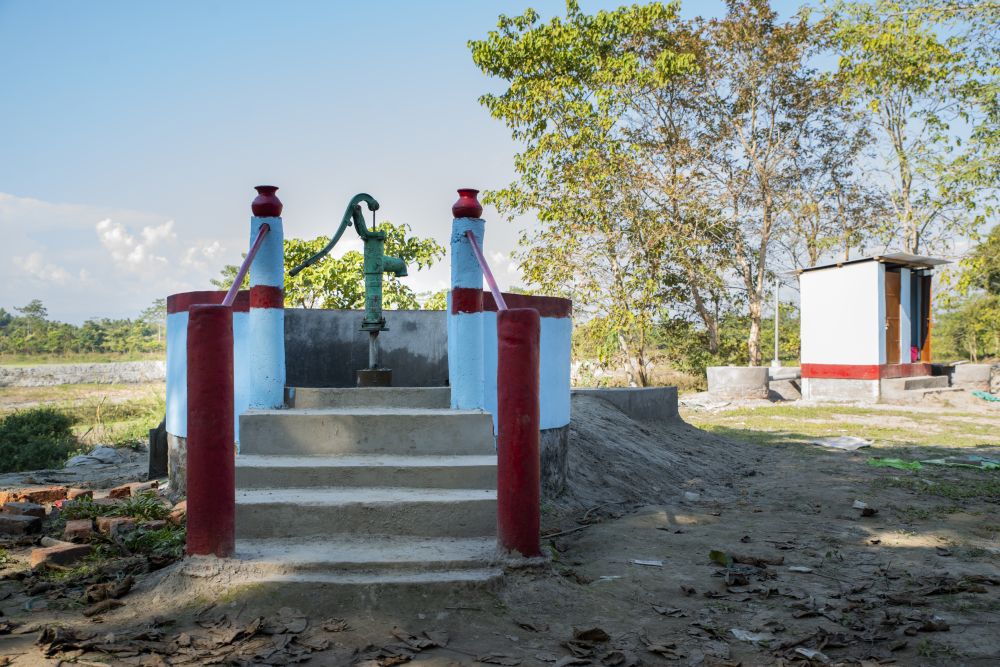Two women in Medipamua village, Dhemaji district, Assam. (Morung Photo)
Akangjungla
Dhemaji | January 5
“I feel lonely,” a 30 year old woman said as she shares her story of living with flood in her village – Medipamua.
Medipamua village is located in Dhemaji district, Assam. According to Assam State Disaster Management Authority (ASDMA), Dhemaji is one of the most flood-affected districts in the state. It is home to 6,86,133 people. The annual floods affect over 1,25,000 people including women and children. During the current wave of floods between May-July 2022, over 1,00,000 people, including 30,000 children were impacted.
Most villages in Dhemaji are located along the river, and when it overflows, croplands are damaged, and cattle and houses are washed away. Faced with the impact of floods including ‘displacement and loss of livelihood; critical service delivery mechanisms including social sector services affected; and increased vulnerability of children, in terms of loss of learning, access to clean water and sanitation, safety measures, proper nutrition, among others,’ the affected communities grapple with how to keep their families, livestock and land protected.

High raised house constructions are common in the Medipamua village as a flooding adaptation practice. (Photo Courtesy: UNICEF/Adish Baruah)
Living with floods
The young mother from the Mishing community (an indigenous community inhabiting parts of Assam and Arunachal Pradesh) has been married for the past 13 years. She lives with her eight year old son and in-laws. “My husband works in a glass company in Maharashtra. He comes home once in one or two years,” she said.
With her spouse away from home for earning income, like many other menfolk from her village, she is often left by herself to face the challenges during the extreme flooding season. “It is tough to reach a place of safety. Everything is affected – field, livestock, schooling and many more. I have to row the boat and transport my family and other necessities to a raised area,” she adds.
Padmavade Dholey is a 50 year old widow. She manages to run the house and maintain her daughter’s college education fairly by faming while her son has moved to Pune for earning and financially supporting his mother and sister.
“I miss my son and want him to stay here but situation is such that even if I want, I cannot ask him to come back,” Dholey said.
The Medipamua villagers recollect depending solely on paddy farming for trade and sustenance; however, due to the extreme flooding and its after affects, the agriculture patterns are drastically changing. The villagers enlighten that after the flooding subsides, the accumulation of sand silt causes major setback for farming.
Sand disposition in riverside villages, especially in paddy fields, is a long-term impact of flooding that increases with each rainfall event (more sand and less fertile silt in flood waters is one reason). Reports have established that ‘farmers’ livelihoods have suffered as a result, with many resorting to daily wage labour jobs to keep their families afloat.’
‘For eight months we face the problem of floods and then it takes one-and-a-half months to remove the silt from the fields. After that with the little grown in the remaining time, we somehow manage to feed ourselves and our families,’ Shivshankar Moitro relates.

Tube wells/hand pumps, toilet with raised platforms in Medipamua village. (Photo Courtesy: UNICEF/Adish Baruah)
Moving to higher ground
For the local communities, in the risk of losing their source of livelihood and generations, resilience is rooted in their in-depth knowledge of the landscape, and operating their indigenous knowledge to scale up safety measures and adapting unique models.
“High raised house constructions are common in the village. All the houses are constructed in such a way that it is not completely washed away by water. The pillars above the ground are raised higher,” a villager informed. During dry season, women use the underground space of the house for weaving mekhala, muffler and other traditional clothes.
“Every household has a boat which remains the most reliable and functional mode of transportation during calamity,” a youth shares while adding, “we learn to row the boat very early because it is a necessity here.”
Today the community initiatives are reinforced by intervention from various stakeholders including the locals (Gram Panchayat, youth club, ASHA and Anganwadi workers), organisations like Rural Volunteers Centre and UNICEF Assam. The Assam government is also a participant in this convergence.
With the interventions, the affected-villages including Medipamua have constructed raised platforms for the locals to take shelter during flooding. Among others, UNICEF Assam under its Risk-Adapted Programme in Dhemaji district has undertaken its pilot project of tube wells/hand pumps, toilet with raised platforms in Medipamua village.






